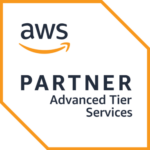Teams face steep learning curves moving to the cloud.
Learn to do it right the first time.
Without proper training, you risk inefficiencies, security vulnerabilities, and missed opportunities for innovation. Our hands-on, on-site training workshops, led by senior architects, are designed to empower your teams to build real-world, working software from day one.
AWS Enterprise Best Practices
Audience – Operations teams, IT administrators
- Understand the best practices that will set your AWS organisation up for security, compliance and productivity
- Establish secure and easy-to-understand methods of providing AWS access to multiple users and groups
- Get off on the right foot with a secure, scalable and performant network that integrates into existing networks and other AWS accounts
- Understand security considerations and tooling to stay on top of threats and breaches
- Know how to establish configuration management to get oversight of all AWS resources and use CloudTrail to monitor and query changes to infrastructure
- AWS Organisations
- SSO
- VPCs
- Multi-account networking
- Auditing with CloudTrail
- Security fundamentals
- Compliance rules
-


AWS Development Fundamentals
Audience – Development teams, DevOps teams and solutions architects
- Know how to create entire applications using Infrastructure as Code
- Understand Terraform, and CloudFormation, where to use both and how to manage them in a consistent, modular way
- Putting observability into every application on AWS and using AWS services to monitor, troubleshoot and prevent issues including cost and billing issues!
- Establish good practices for managing credentials with SSO, IAM, cross-account access and elevated privileges
- Understand the trade-offs between AWS native CI/CD services and GitHub Actions or other third-party services
-
- Working with multiple accounts and environments
- Infrastructure as Code – CloudFormation and Terraform
- Identity and Access Management (IAM), how it works and how to make it work for productive development
- Managing credentials for productivity without compromising security
- Observability with CloudWatch Logs, Alarms, Metrics and Insights
- Cost management; tagging, cost explorer and budgets
- CI/CD: GitHub Actions with AWS, CodeBuild and CodePipeline
- Development tooling
-
-
Full-stack Serverless Development on AWS with Node.js
Audience – Software development teams, including backend and frontend engineers
We also offer a variant of this training programme for Python developers
- Prepare developers for full-stack serverless development with JavaScript/TypeScript on AWS
- Be able to understand and contribute to frontend (React), backend (Node.js) and cloud deployments (AWS with CDK)
- Understand Node.js/JavaScript ecosystems, tooling and development best practices
- Get people comfortable with the fundamentals and make them able to continue the journey on their own
-
-
See what the NN Group have to say about this training.
- JavaScript and TypeScript
- Node.js tooling and ecosystem
- Callbacks, Promises and async/await
- Serverless development on AWS
- AWS CDK and SAM
- Lambda
- API Gateway
- DynamoDB
- SQS
- SNS
- EventBridge
- Troubleshooting with CloudWatch Logs Insights
- Testing
- Frontend development with React
- Building an example e-commerce application
-
-


Event-Driven Application Development on AWS
Audience – Software development teams, both backend and frontend engineers
- Gain an in-depth understanding of all the key AWS services for sending events within and across applications
- Understand constraints, performance and delivery semantics for every service
- Know how to integrate services like SQS, SNS, EventBridge and Kinesis to other AWS services, including S3, Lambda, Step Functions, EC2 and ECS
- Understand how to build a cross-domain event backbone for your organisation and how to resist tight coupling while building consistency and maintainability into your message flows
- Get comfortable tracing and tracking missing or failed events in development or production workflows
-
- Message and event patterns
- Event buses, pub/sub and point-to-point channels
- Performance characteristics, delivery guarantees and limits
- Error handling, monitoring, dead letter queues and redelivery
- SQS
- SNS
- EventBridge
- Kinesis
- Kafka and MSK
- Creating a cross-account event backbone
- Internal application events
- Event structure, schemas and validation
- Integrating events to other AWS services
- Logging, monitoring and troubleshooting for event-driven applications
-
-
Migrating to a data lakehouse and data analytics in AWS
Audience – Development teams, Data teams and solutions architects
- Get a deep understanding of the key AWS services used for data storage, querying and transformation
- Understand which service is best suited to each scenario
- Understand the cost implications of a real-time v batch ETL job
- Know how to integrate services like S3, Glue, Lambda, Step Functions and Athena to create an end-to-end data platform
- Create dashboards and Machine Learning models
-
-
- Creating a Data lakehouse on Amazon S3 (storage)
- AWS Athena for querying data in the Data Lakehouse
- Using AWS Glue for event-based ETL
- Data ingestion using batch (upload to S3 / SFTP) and real-time (API Gateway, Transfer Family, Lambda)
- Build a scheduled task to move data from an on-premise database to AWS.
- Building dashboards using Power B.I. or Quicksight
- ETL pipelines using AWS Step Functions.
- Alerting, monitoring and observability of workloads
- Using AWS managed A.I. services
- Creating and deploying machine-learning models
-
-



